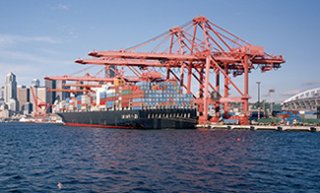Technical Resources for Ports

Assessments and Strategies
- Quantifying and Characterizing Near-Port Populations in the Conterminous United States
In this report, the EPA identified populations near ports in a more sophisticated manner than traditional proximity analyses by leveraging a 2010 high-resolution population dataset of the conterminous United States (CONUS, the lower 48 states and the District of Columbia) and port geometries from two different Federal agencies. This report also characterizes the attributes of these near-port populations.Key findings include:
- At least 31 million people live within 5,000 meters of major ports in the conterminous U.S.
- Near-port populations have higher shares of sociodemographically vulnerable groups than comparison groups, and these differences are not driven solely by the busiest ports.
- A key challenge of this work is the complexity of mapping and defining port operations geospatially.
- Shore Power Technology Assessment at U.S. Ports
This assessment characterizes the technical and operational aspects of shore power systems in the U.S. and shows an approach for comparing shore power and vessel emissions while at berth. - Port Operational Strategies
This series of port operational strategy fact sheets provides information to inform port stakeholders about potential emission reduction strategies. Each fact sheet contains basic information about the strategy, emission impacts, cost components, and example programs. While each strategy can achieve benefits on its own, implementing them together could create synergies.- Port Gate Management Strategies Improve Air Quality and Efficiency at Ports
- Management Information Systems Improve Operational Efficiencies and Air Quality At Ports
- Marine Vessel Speed Reduction Reduces Air Emissions and Fuel Usage
- Virtual Vessel Arrival Systems at Ports Improves Air Quality and Saves Fuel
- Port Emissions Inventory Guidance: Methodologies for Estimating Port-Related and Goods Movement Mobile Source Emissions
This guidance describes the latest, state-of-the-science methodologies for preparing port-related emissions inventory for the following mobile source sectors: ocean-going vessels, harbor craft, recreational marine, cargo handling equipment, onroad vehicles, and rail. This guidance may be used for regulatory, voluntary, and research purposes. - Assessment of Fuel Cell Technologies at Ports
This report assesses the potential for fuel cell technologies to replace diesel engines across a variety of port applications and thus significantly reduce diesel emissions. The report characterizes fuel cell systems, their history, and their potential utilization at ports and compares their emissions, cost, maintenance, and other features to traditional diesel applications. Assessment of Fuel Cell Technologies at Ports (pdf) (July 2022, EPA-420-R-22-013)Key findings include:
- Fuel cell technology promises significant advantages over current diesel-fueled port equipment for a broad array of port applications, including lower criteria pollutant, greenhouse gas, and noise emissions; higher energy efficiency and lower petroleum use; diverse fueling capability; and potentially lower maintenance requirements.
- Fuel cell technologies are commercially available for forklifts and stationary power applications at ports, and are under development for drayage trucks, yard tractors, cargo handlers (top loaders), switcher locomotives, and marine vessels such as harbor craft.
- In most cases, fuel cell equipment in port applications achieve significant lifecycle emission reductions for both air pollutants and greenhouse gases, however emissions benefits vary depending on how the hydrogen is produced and transported.
- Due to its early stage of development, higher hydrogen fuel prices, lower volume production, and current delivery options, port fuel cell equipment currently costs more to operate relative to comparable diesel-fueled equipment but costs are expected to decrease over time.
- National Port Strategy Assessment
This national scale assessment examines current and future emissions in port areas; explores available strategies to reduce emissions from port-related vehicles; and provides an assessment tool for state and local governments, ports and port operators, Tribes, communities, and other stakeholders. - Northwest Ports Clean Air Strategy
This case history provides an overview of the Northwest Ports Clean Air Strategy goals, progress toward meeting performance targets and outcomes that have reduced emissions and improved air quality in the Port of Seattle, Port of Tacoma, and Port Metro Vancouver, Canada.
Other Resources
- EPA Partnership with Port Everglades
This partnership seeks to develop baseline and future year emission inventories and to evaluate various effective technology and operational strategy scenarios for seaports. - Verified Technologies
View EPA-verified technologies and retrofit technologies that save fuel and reduce emissions.
